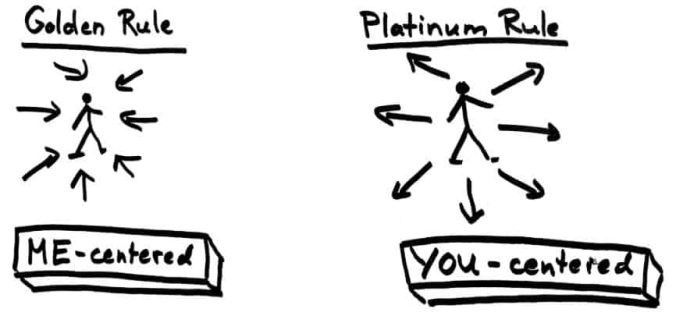“Treat others as you would like to be treated.” We’ve all heard the phrase. It’s a splendid concept except for one thing: Everyone is different, and the truth is that in many cases what you’d want done to you is different from what your partner, employee, customer, investor, spouse, or child would want done to them. What appears to be empathy is, in fact, very self-serving. By treating people the way we want to be treated, we are most likely treating them inappropriately.
In our modern workplace, with all our different preferences, cultural backgrounds, professional disciplines, ages, genders, sexual orientations, etc., treating others as you would like to be treated isn’t always the best option. Although it can be helpful to put yourself in someone else’s shoes, doing so can actually lead to making assumptions based on your own perspective — not theirs.
It’s time to adopt the “Platinum” Rule: Treat others as they would like to be treated. This should be the fundamental maxim for effective relationships. All it takes to put this new mindset into practice is understanding, curiosity, and compromise.
- Remember that your way is not the best or only way: We have an innate tendency to become enamored with our own choices. Remember that there are many alternatives available to reach the same destination. Provide people with the autonomy that facilitates their self-expression. This type of experimentation will facilitate better engagement and maybe even improved results. When we rely too heavily on our own perspectives, we miss out on the diverse and important viewpoints around us.
- Challenge your assumptions: We are all a unique mix of genetics, experiences, and desires. Generalizing other people and their characters can be very dangerous — and more often than not, our generalizations are inaccurate. When you find yourself making assumptions about another person, ask:
- Where are these beliefs coming from?
- What information am I missing?
- Why do I think my assumptions are true?
- Are there any alternative explanations or possibilities?
- Are my assumptions based off my own experiences and understanding of the world, and if so, am I being biased?
- Ask questions and listen: The best way to really find out how someone else would like to be treated is to simply ask. Make it a point to understand what your direct reports and your team need from you. Likewise, don’t be afraid to let others know directly about your own preferences. Assumptions can be misleading. Disclosing our preferences and asking more questions can help eliminate misunderstandings. Some sample questions to ask might be:
- How do you prefer to communicate – phone, email or jabber?
- In what format do you need the information about this project?
- Learn your team’s strengths: Identifying and leveraging the strengths of the people around us is critical to our success as well as the success of the team. This can be achieved by asking your team members when they feel “in the zone” at the office and pose similar queries to their closest colleagues/team members. You can also use strengths-based assessment tools to better inform the conversation.
Recognizing people for who they are and giving them what they need is the cornerstone of building stronger relationships in our personal and professional lives. Adopting the Platinum Rule and realizing its potential by focusing on others will be an invaluable exercise for ourselves, our teams, our organizations, and our communities.
References:
Harvard Business Review (2022, August 2) Irina Cozma: It’s Time to Stop Following “The Golden Rule”
Financial Post (2013, November 15) Craig Dowden: Want to Be Liked as a Leader? Stop Treating Others as You Would Want to Be Treated
CEO World Magazine (2019, June 26) Shelley Flett: Treat Others the Way They Want to Be Treated – Not How You Want to Be Treated
Inc. (2016, March 17) Peter Economy: How the Platinum Rule Trumps the Golden Rule Every Time


Leave a Reply